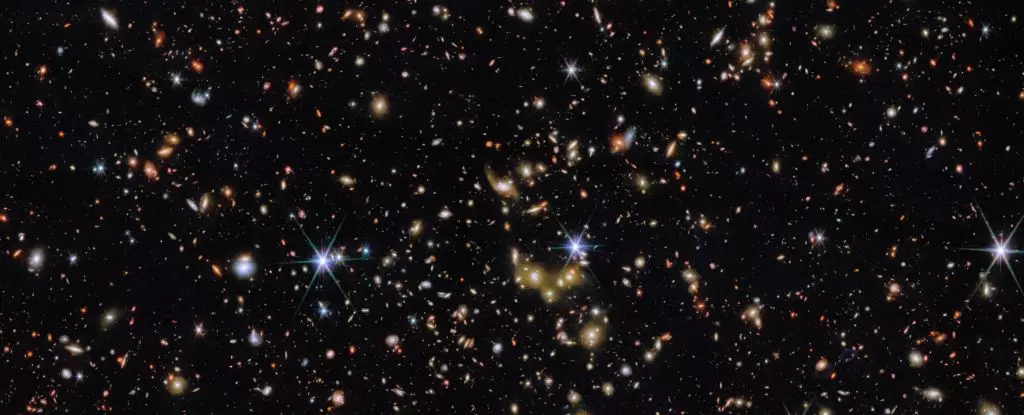In a monumental display of cosmic ballet, the James Webb Space Telescope (JWST) recently delivered an unparalleled deep field image that reshapes our understanding of the universe. With the gaze of the telescope piercing through nearly 12 billion light-years, our perception of the celestial realm is forever altered. This astonishing view, captured from an area less than one-fifth the width of the full moon, reveals a bustling landscape of distant galaxies twinkling against the dark canvas of space.
What fuels this fascination is not merely the visual spectacle but the depth of human curiosity it ignites. Looking up on a clear night from Earth, one might see a sprinkling of bright stars, feeling a sense of connection to the cosmos. Yet, in this new image, many of those radiant points are not solitary stars but entire galaxies, each harboring billions of stars, some of which form within the first billion years after the Big Bang. Such revelations about our origins stir a primal sense of wonder and insignificance within us.
The Defining Characteristics of Celestial Bodies
One striking aspect of the JWST images is the identification of foreground stars, easily distinguished by a characteristic diffraction pattern. This pattern appears as pointy spikes that emerge when light from a concentrated source, such as a star, is refracted through the telescope’s intricate design. In contrast, the diffuse light emanating from galaxies does not exhibit this spike formation, magnificently illustrating the difference between local and distant celestial objects.
Being able to discern these variations not only adds to our observational capability but bolsters our understanding of the makeup of the universe. The central group of galaxies in this specific image emits a radiant golden light that illuminates the complexity of cosmic formation. The light captured has journeyed for around 6.5 billion years, a testament to the scale of cosmic time that bathes us in the intensity of this glimpse into the universe’s evolutionary past.
The Cosmic Web Connecting Galaxies
The latest deep field image is not just a collection of spectacular celestial bodies but a clear reflection of the underlying structure of the universe, the cosmic web. This delicate framework—composed of dark matter and hydrogen—acts as a scaffold, organizing galaxies into clusters. The connections between these groups paint a picture of gravitational threads weaving a tapestry of cosmic architecture.
Moreover, the COSMOS-Web survey, responsible for this groundbreaking imagery, highlights how much more there is to find within the fabric of the cosmos. By merging data from JWST with X-ray observations from the Chandra X-ray Observatory, researchers can unveil the colossal size and mass of galaxy clusters hidden in plain sight. With the heat generated by the gas that suffuses the clusters glowing in X-radiation, the insights produced offer a powerful commentary on the interconnected nature of cosmic entities.
An Ocean of Galaxies, Waiting to Be Discovered
What is most staggering is not only the complexity visible within this single image but the vastness of what lies beyond it. An international team, spearheaded by astrophysicist Greta Toni from the University of Bologna, has cataloged a mind-boggling 1,678 groups of galaxies from such a minuscule slice of the universe. This quantity emphasizes that this tiny patch of sky is representative of a nearly infinite multitude of galactic clusters awaiting further exploration.
The implication that every other seemingly empty spot in the night sky likely harbors an equal multitude of galaxies serves as a humbling reminder of our place in the cosmos. It ignites a passion for exploration and research that is critical in our quest for knowledge. Each image captured, each distant flare of light, provides a fragment of the grand puzzle of existence—the ongoing story of the universe unfolding before our very eyes.
The Endless Journey of Cosmic Exploration
These deep field images do not merely serve as visual wonders; they represent the potential to answer fundamental questions about the nature of the universe, the formation of galaxies, and ultimately, our very existence. As we peel back the layers of the cosmos, driven by our insatiable thirst for understanding, we find ourselves captivated by the endless journey ahead. Through the lens of the JWST, we are reminded that the limits of our knowledge are continuously shifting, inviting new generations of scientists—and humankind—to join in the exploration of the infinite cosmos that surrounds us.

